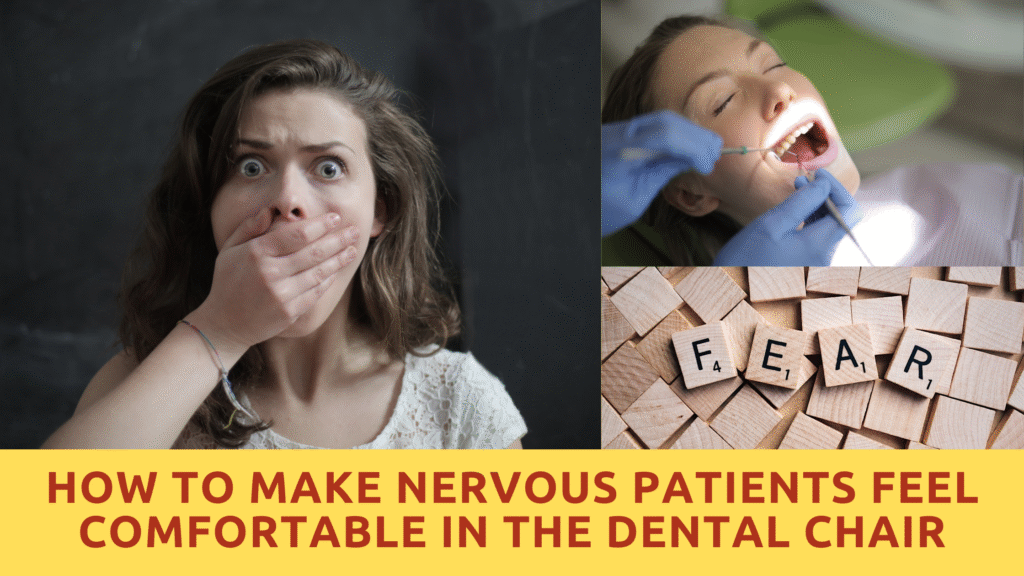Dental anxiety is one of the biggest barriers that prevent patients from visiting a dentist regularly. Whether it’s fear of pain, needles, or past negative experiences, nervous patients need extra care and attention to feel safe. As a dentist, creating a welcoming and calming environment is key to gaining their trust and ensuring treatment success.
In this blog, we’ll share effective strategies to calm anxious dental patients—especially useful for new dentists or clinic owners looking to improve patient experience.
1️⃣ Understand the Root Cause of Anxiety
Before trying to calm the patient, first identify why they are nervous. Common reasons include:
- Fear of pain
- Past traumatic dental experiences
- Fear of injections or instruments
- Embarrassment about oral health
✅ Tip: Ask open-ended questions during consultation like:
“Have you had any unpleasant dental experiences before?”
“Is there anything specific you’re worried about today?”
2️⃣ Build Trust Through Friendly Communication
Your tone and body language play a crucial role. Use:
- Warm greetings and eye contact
- A calm, confident, and empathetic voice
- Simple, non-technical explanations
✅ Tip: Always explain what you’re doing before you do it. Patients fear the unknown more than the procedure itself. Learn how you can build Trust- Click Here (Paid Course).

3️⃣ Modify the Clinical Environment
Small environmental changes can make a big difference:
- Soft lighting instead of harsh white lights
- Calming music or noise-canceling headphones
- Soothing colors and artwork on the walls
✅ Tip: Use aromatherapy diffusers (lavender or peppermint) to create a relaxed atmosphere.
4️⃣ Use the Tell-Show-Do Technique
One of the best ways to reduce fear is the Tell-Show-Do method:
- Tell the patient what you’ll do in simple words
- Show them the instrument and how it works (harmlessly)
- Do the procedure gently
✅ Tip: Let them hold a mirror to see what’s going on if they’re curious. Knowledge reduces fear.
5️⃣ Offer Control Back to the Patient
Fear increases when a patient feels helpless. Give them options:
- Pre-decide a “stop” signal (like raising a hand)
- Offer short breaks during longer procedures
- Ask for feedback often: “Are you okay? Shall we continue?”
6️⃣ Use Distraction Techniques
Engage their mind to shift focus from fear to something else:
- Play relaxing music or podcasts
- Let them watch a movie if your setup allows
- Offer stress balls or weighted blankets
7️⃣ Consider Sedation (When Necessary)
For extreme cases, discuss safe sedation options:
- Nitrous oxide (laughing gas)
- Oral anti-anxiety meds (prescribed appropriately)
- IV sedation in moderate to severe cases (specialist required)
Always explain risks and get informed consent before proceeding.
8️⃣ Follow-Up & Positive Reinforcement
After treatment:
- Praise them for their courage
- Offer simple oral hygiene tips they can maintain
- Send a thank you message or follow-up SMS
This builds a lasting relationship and reduces anxiety in future visits.
✅ Final Thoughts
Managing nervous patients is a blend of psychology, patience, and compassion. When done right, you not only ease their fears but also turn them into loyal patients who refer others. Learn How to Grow a Dental Clinic: Proven Strategies for Dentists.
By focusing on how to calm anxious dental patients, you improve your clinic’s reputation, boost retention, and most importantly—deliver better care.
